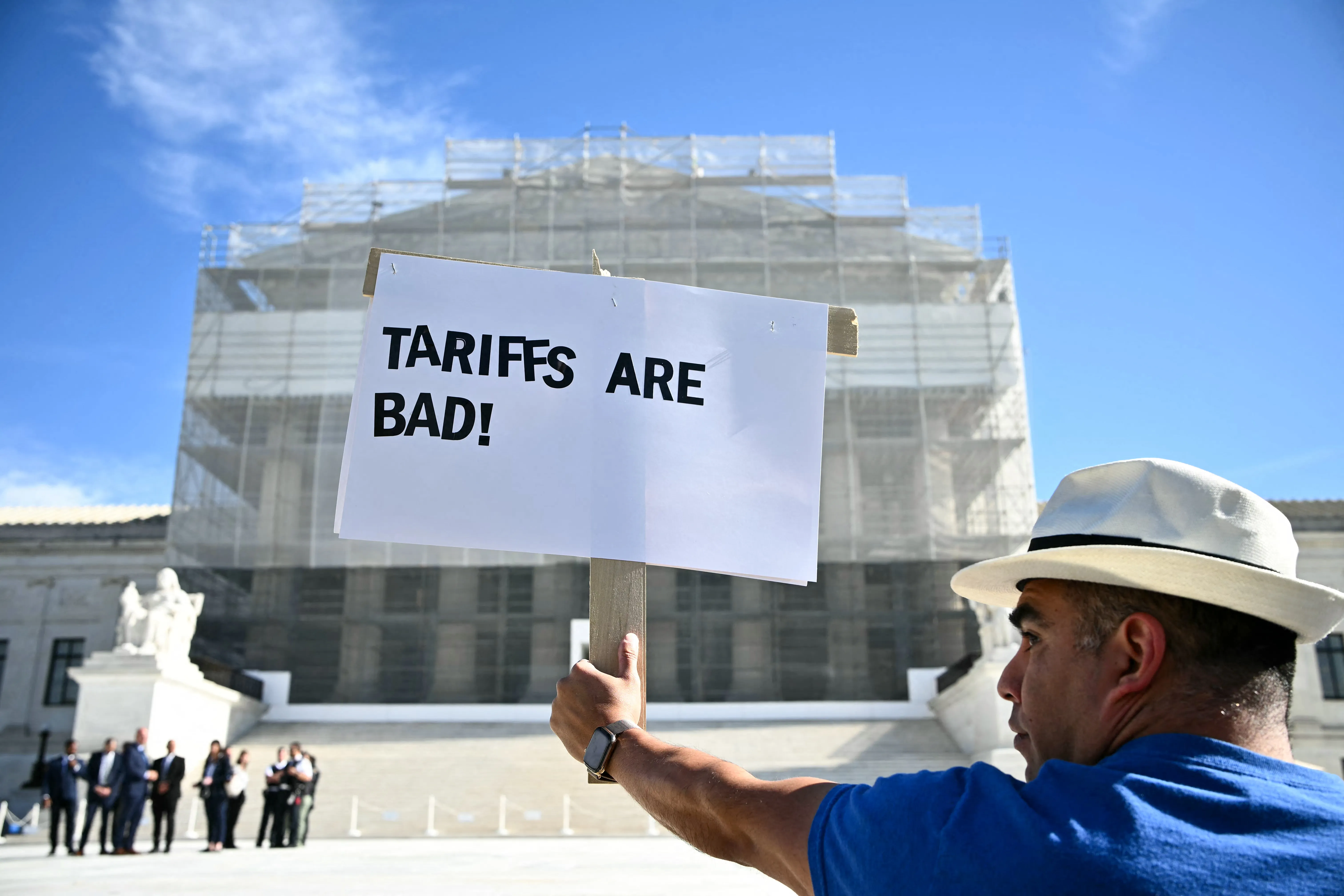
Key takeaways
- The Supreme Court might soon overturn most of Trump’s tariffs.
- If those tariffs ceased to exist, prices would fall, growth would accelerate, and employment would rise.
- But Trump can probably reinstate any overturned tariffs on a different legal basis.
The Supreme Court may soon upend President Donald Trump’s trade war.
Various state governments and small businesses are challenging the legality of most of Trump’s tariffs. Their case reached the Supreme Court a week ago. In oral arguments, a majority of justices appeared to side with the plaintiffs — and it isn’t hard to see why they might have such sympathies.
To justify the bulk of his tariffs, Trump has invoked the International Emergency Economic Powers Act (IEEPA), a statute that empowers the president to “regulate” transactions in response to “unusual and extraordinary” threats amid national emergencies. In the administration’s view, this law authorizes them to impose tariffs on more or less any nation, since America’s trade deficit constitutes an unusual and extraordinary threat to the United States.
But the idea that a trade deficit constitutes such a calamity is disputed by most economists and legal scholars. And it’s not clear that the IEEPA authorizes broad tariffs in any case: “Regulating” a transaction is not necessarily the same thing as imposing a tax on imports. And it’s not clear that Congress can constitutionally give presidents completely open-ended authority to impose new tariffs, given that the legislative branch is supposed to hold the power of the purse.
If the Court overturns Trump’s tariffs, the economic consequences for ordinary Americans could be profound — at least, until he finds new legal rationales for deliberately driving up the cost of living.
The Supreme Court may soon increase your income by $1,000
Since taking office, Trump has massively increased taxes on imports. In January, the average US tariff was 2.5 percent. Now, it is 17.9 percent — the highest since 1934 — according to the Budget Lab at Yale.
This has taken a toll on the US economy. By taxing various foreign-made industrial inputs — from steel to semiconductors to lumber — Trump has made it more expensive for American companies to produce things. And by taxing imported goods, he’s driven up retail prices. As a result, he has made America’s industries less productive and its households less wealthy than they otherwise would have been.
According to a recent analysis from the Budget Lab, Trump’s tariffs are poised to slow economic growth by 0.5 percentage points in 2025 and 2026. If maintained indefinitely, his trade regime will leave the American economy persistently 0.35 percent smaller, effectively shedding $105 billion off our national wealth, year after year.
The tariffs are also likely to raise America’s price level by about 1.3 percent in the short run. This would effectively cost the average household $1,800 in annual income, due to higher expenses. Making matters worse, by depressing consumption and investment, the tariffs are set to marginally increase unemployment. In the Budget Lab’s model, joblessness rises by 0.3 percentage points by the end of this year and 0.7 points by the end of next year.
If the Supreme Court invalidated all of the tariffs that Trump imposed under IEEPA authority, most of these harms would disappear.
The president has enacted tariffs using a variety of distinct powers. An unfavorable Supreme Court ruling would therefore leave some of his trade regime intact. But it would still push America’s average tariff rate down to 9.1 percent. According to the Budget Lab, that would translate into:
- An increase in the price level of only 0.6 percentage points (instead of 1.3).
- A reduction in annual US household income of only $770 (instead of $1,800).
- An increase in unemployment of 0.2 percentage points by the end of 2026 (instead of 0.7 points).
- And a reduction in 2026 economic growth of only 0.1 percentage points (instead of 0.5 points).
The only major benefit of the tariffs has been their impact on federal deficits. Trump’s trade agenda is poised to raise about $2.2 trillion in revenue over the coming decade. The repeal of the tariffs would cut that by more than half.
Nonetheless, taken together, the overturning of the tariffs would provide a significant economic stimulus — increasing the average household’s real annual income by more than $1,000, accelerating growth, and reducing unemployment.
And all that is before accounting for the impact of tariff reimbursement payments: When the government levies an illegal tax, it isn’t allowed to retain that revenue. Rather, every importer that paid a tariff this year would be entitled to a refund — one paid back at a 6 percent annual interest rate, compounded daily. To make full restitution, the government would need to send out more than $100 billion to US businesses.
The stimulative impact of those reimbursements would likely be modest. The government wouldn’t immediately mail out $100 billion in checks. Rather, every affected importer would need to individually apply for relief, a process that could take years. Nevertheless, reimbursements would boost business revenue — and thus potentially, investment — at the margin.
Of course, stimulating the economy can entail costs. Typically, slashing taxes and increasing deficits nudges up inflation: When you put more cash in people’s pockets, they can bid up the prices of goods and services to a higher level.
But since Trump’s tariffs directly increase the cost of both consumer goods and industrial inputs, lifting them would likely spark growth and dampen inflation simultaneously. Ending the trade war would therefore be a win-win. Unfortunately, it is a “win” that Trump will likely do everything in his power to avoid.
How Trump’s tariffs could rise again
Trump enacted most of his tariffs using the IEEPA for a reason: Since that statute is meant to facilitate swift presidential action during an emergency, it doesn’t require the administration to complete any onerous bureaucratic process before imposing import taxes. By contrast, the White House cannot invoke many other tariff powers without conducting investigations and/or hearings.
Nevertheless, those other powers are considerable. The Trade Act of 1974 authorizes the president to enact duties of unlimited scale on foreign countries that engage in unfair trade practices. Trump is already using this law to place tariffs on Chinese goods.
Separately, that law authorizes the president to impose across-the-board tariffs of up to 15 percent for 150 days, in response to a large trade deficit.
The Trade Expansion Act of 1962, meanwhile, allows the administration to impose tariffs when imports threaten America’s national security. Trump has already interpreted this authority expansively: In the administration’s account, cheap foreign-made cabinets are a threat to the US homeland.
Taken together, these laws — along with a handful of others — could allow Trump to reimpose virtually all of his tariffs. But the process of rebuilding his trade regime could be lengthy and cumbersome.
To enact tariffs in response to unfair trade practices, the United States Trade Representative must conduct an investigation demonstrating such cheating, a process that can take months. Likewise, to impose duties in the name of national security, the Commerce Department must document the supposed threats in question.
This said, in the wake of an unfavorable Supreme Court ruling, the administration could immediately enact temporary, 15 percent tariffs on any country it wishes. That would buy it 150 days to conduct sham investigations authorizing permanent tariffs through other authorities.
To be sure, it is possible that this would lead to new legal challenges. And the Supreme Court could theoretically rule that every law delegating sweeping tariff powers to the executive branch is unconstitutional. But legal scholars generally believe that Trump’s use of the IEEPA has been drastically more legally dubious than his invocation of other trade authorities.
Thus, if the Supreme Court rules against Trump in the IEEPA case, tariffs would likely decline slightly in the short-term. But in the longer run, they could eventually creep back up to something approaching their current level — thereby raising prices, slowing growth, and reducing employment, relative to a world without Trump’s tariffs.
Trump may welcome an excuse to scale back his self-sabotage
All this said, the Trump administration has strong political incentives to pare back its trade war. Americans’ top concern is the cost of living. And they overwhelmingly disapprove of Trump’s handling of both trade and inflation.
Trump may have dismissed such polling as “fake news.” But he seems to have been rattled by the GOP’s dismal showing in the 2025 elections. The morning after Democrats stomped to victory in Virginia, New Jersey, Georgia and other states, Trump declared on Truth Social, “Costs are coming way down. Affordability is our goal.”
In this context, the White House might see an adverse Supreme Court ruling as an opportunity to reset its trade policy — without needing to explicitly admit error. By claiming that his hands have been tied by a corrupt judiciary, Trump could seek to replace some, but not all, of his tariffs without losing face.
If Trump wants to make America poorer in service of his economically illiterate trade ideas, however, the Supreme Court probably won’t stop him. Rather, it will just force Trump to pursue such self-sabotage in a more laborious and bureaucratic manner.
The post The Supreme Court just might save Trump from himself appeared first on Vox.




